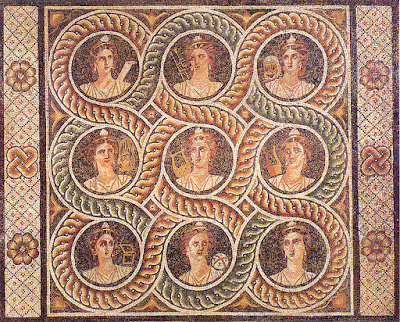The Muses (Ancient Greek: Μοῦσαι Mousai; perhaps from the Proto-Indo-European root *men- "think") in Greek mythology are the goddesses of the inspiration of literature, science, and the arts.
They were considered the source of the knowledge embodied in the
poetry, song-lyrics, and myths that were related orally for centuries in
these ancient cultures. They were later adopted by the Romans as a part
of their pantheon.
The Muses, the personification of knowledge and the arts, especially literature, dance and music, are the nine daughters of Zeus and Mnemosyne
(memory personified). Hesiod's account and description of the Muses was
the one generally followed by the writers of antiquity.
It was not
until Roman times that the following functions were assigned to them,
and even then there was some variation in both their names and their
attributes: Calliope (epic poetry), Clio (history), Euterpe (flutes and lyric poetry), Thalia (comedy and pastoral poetry), Melpomene (tragedy), Terpsichore (dance), Erato (love poetry), Polyhymnia (sacred poetry), Urania (astronomy).
Muse
|
Domain
|
Emblem
|
| Calliope | Epic Poetry | Writing tablet, Stylus, Lyre |
| Clio | History | Scrolls, Books, Cornet, Laurel wreath |
| Euterpe | Music, Song, Ellegiac Poetry | Aulos (an ancient Greek musical instrument like a flute), panpipes, laurel wreath. |
| Aerato | Lyric Poetry | Cithara (an ancient Greek musical instrument in the lyre family) |
| Melpomene | Tragedy | Tragic mask, Sword (or any kind of blade), Club, Kothornos (boots) |
| Polyhymnia | Hymns | Veil, Grapes (referring to her as an agricultural goddess) |
| Terpsichore | Dance | Lyre, Plectrum |
| Thalia | Comedy | Comic mask, Shepherd's crook (the vaudeville act of pulling someone off the stage with a hook is a reference to Thalia's crook), Ivy wreath |
| Urania | Astronomy | Globe and compass |
And so we know of many mosaics describing them 9 muses.
A gorgeous Set was discovered in Zeugma, Turkey in 2014.
And an other amazing set in the Island of Rhodes.
And an amazing one was unearthed much more to the North in the Vilage of Viichter close to Luxembourg.
In a next Post, I'll show you some individual portraits of our 9 Μοῦσαι.
I
am a modern mosaic artist with a deep admiration for ancient Greek,
Roman and Byzantine Arts. You can see some of my own mosaics on my
site mosaicblues.
If you are interested by my work
or
if you would like to drop me a line, please
contact me by email at frederic.lecut@gmail.com
or by phone at (334) 798 1639.
You can also
to receive regular updates on my present
Yezidi Eyes Mosaic Project,
and my work in general.





The second set of mosaics is in the Island of Kos (not Rhodes}.
ReplyDelete